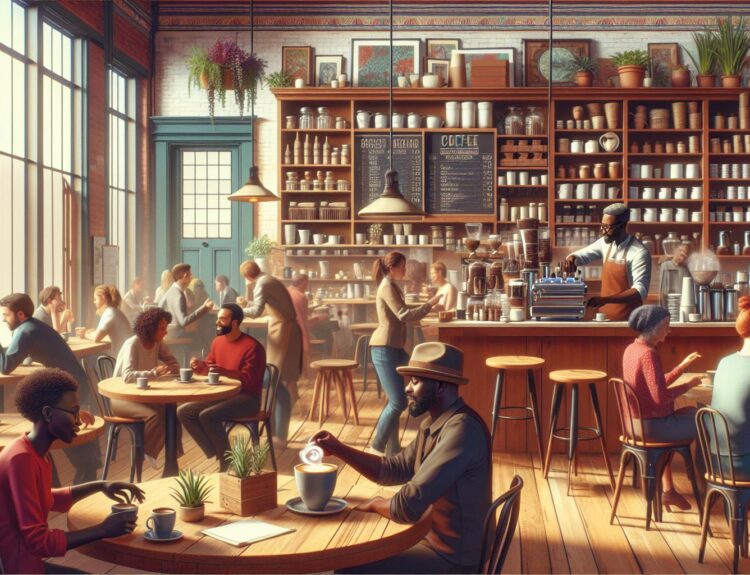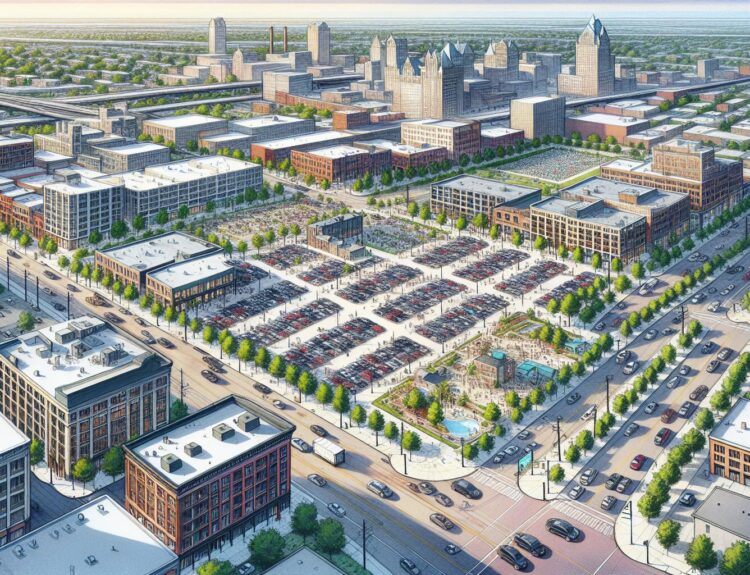Exploring Corktown, Detroit’s oldest neighborhood, feels like stepping back in time. It’s a place where the past isn’t just remembered; it’s lived in, painted on every brick and whispered by the creaking wood of the historic buildings. I’ve always been fascinated by how architecture can tell the story of a city, and Corktown, with its vibrant history and resilient spirit, has stories in spades.
From the iconic Michigan Central Station to the cozy, time-worn taverns, each building in Corktown has a tale to tell. It’s not just about the structures themselves but the lives that have passed through them, the celebrations and struggles, that paint a vivid picture of Detroit’s evolution. Join me as I delve into the heart of Corktown, uncovering the beauty and grit of its historic buildings.
Exploring Corktown, Detroit
As I venture deeper into Corktown, Detroit’s heartbeat grows louder, its pulse echoing through the cobblestone streets and historic facades. This neighborhood, ripe with stories, has become a canvas for the city’s rich past and promising future. Let me take you through some of the landmarks that embody the spirit of this remarkable area.
First stop, Michigan Central Station. Standing as a testament to Detroit’s golden age of automotive industry and transport, this once-abandoned behemoth is now undergoing restoration. It’s not just a building; it’s a beacon of hope and renewal for the entire city. Peering through the fence, I imagine the hustle and bustle of the early 20th century, travelers embarking on journeys, and reunions filled with laughter and tears.
A short walk from the station, the cozy, inviting taverns of Corktown offer a glimpse into the daily life of its residents, past and present. These aren’t just pubs; they’re chapters in Corktown’s ongoing narrative, where every pint served is a nod to the camaraderie and resilience of this community. Places like Nancy Whiskey and McShane’s Irish Pub aren’t just spots for a nightcap; they’re institutions that have weathered economic storms and celebrated countless milestones with their patrons.
Strolling through the neighborhood, the architectural diversity is striking. Each structure, whether it’s a restored Victorian home or a modern infill project, contributes to the mosaic that is Corktown. The historic Trumbull Avenue Presbyterian Church, with its stunning stained-glass windows and towering spire, stands as a hallmark of community and faith, echoing the diverse beliefs and cultures that have found a home in Corktown.
Not far away, Tiger Stadium’s historic site, though now repurposed, reminds us of the city’s love affair with baseball and the collective memories shared by fans throughout the years. It’s a sacred ground where legends played, and dreams soared high above the diamond.
Corktown isn’t just a place to visit; it’s a neighborhood to experience, to feel, and to understand. The historical depth and cultural richness found here offer a unique perspective on Detroit’s evolution. Each step through its streets invites curiosity and wonder, urging one to look beyond the facades and delve into the stories they house.
Michigan Central Station: A Landmark of History
When I first laid eyes on Michigan Central Station, its towering silhouette against the Detroit skyline was absolutely breathtaking. It’s not just a building; it’s a monument to the golden age of automotive industry success and a testament to the city’s resilience. Built in 1913, this historical landmark once buzzed with travelers, serving as a major rail hub in the Midwest.
Stepping inside, you can’t help but feel enveloped by the echoes of the past. The grandeur of its Beaux-Arts architecture, with its massive columns and detailed ornamentation, tells stories of a bygone era. It’s fascinating to see how it has withstood the test of time, despite the decades of neglect it faced after its closure in 1988. The station was once on the brink of demolition, a fate that many of Detroit’s grand buildings unfortunately met. But Michigan Central Station’s narrative took a different turn.
In recent years, there has been a Revitalization Effort aimed at giving this historic gem a second life. The investment in its redevelopment signifies more than just the conservation of a landmark; it’s a beacon of hope for the future of Corktown and Detroit at large. The plans for its transformation include creating a mixed-use space that will house offices, retail, and public areas. This vision for the future respects the building’s historical significance while adapting to the needs of the modern city.
My most memorable visit was during one of the open house events, where the community got a sneak peek at the restoration progress. Walking through the halls, it was clear that every effort was being made to preserve its original beauty. From the restoration of the grand windows that flood the interior with light to the intricate plasterwork that adorns the ceilings, the attention to detail is impressive.
The story of Michigan Central Station is a powerful reminder of Detroit’s ability to reinvent itself while honoring its roots. It stands as a symbol of hope and determination, characteristics that define this city and its people. As this landmark enters a new chapter, it continues to inspire those who believe in the power of restoration and the importance of preserving our historical treasures for future generations to admire and learn from.
Cozy Taverns: Preserving Corktown’s Character
Wandering through Corktown, Detroit’s oldest neighborhood, I can’t help but admire how every brick and cobblestone whispers stories of the past. Amid this historical tapestry, it’s the cozy taverns dotting the streets that truly capture the essence of Corktown’s character. These aren’t just drinking spots; they’re living monuments to community and resilience, embodying the spirit of the city itself.
One such place, Nancy Whiskey, has been serving locals and visitors alike since 1902. It’s not hard to see why it’s lasted so long. The warmth that greets you when you step inside isn’t just from the century-old wood-burning stove; it’s in the smiles of those who make this place a second home. Here, the history isn’t locked in a display case—it’s in the very walls that have witnessed generations of laughter, debates, and camaraderie.
Another gem, McShane’s Pub, seamlessly blends Irish hospitality with Detroit’s gritty charm. It’s a place where you can savor a hearty meal, enjoy a cold pint, and at the same time feel like you’re a part of something bigger. McShane’s isn’t just about preserving a cultural heritage; it’s about creating a space where everyone, from local artisans to visiting tourists, can come together, forging new memories while paying homage to those who walked these streets before us.
The stories these taverns hold are not just told through words or old photographs. They come alive in the nightly gatherings, the spontaneous music sessions, and the shared comfort of a familiar place. It’s in venues like PJ’s Lager House, where every drink served and song played adds another layer to Corktown’s rich narrative. Celebrated for its live music scene, PJ’s isn’t just keeping the tradition of entertainment alive; it’s ensuring that the community’s creative heartbeat remains strong.
What stands out most about Corktown’s taverns is their commitment to preserving the neighborhood’s character while embracing change. As Corktown evolves, these establishments adapt, ensuring that what makes this area unique isn’t lost to modernization. They serve as anchors, reminding us of the resilience and vibrant culture that defines Detroit.
Uncovering the Tales of Corktown’s Historic Buildings
As I’ve wandered through Corktown, Detroit’s oldest neighborhood, I’ve been captivated by the stories that its historic buildings whisper through their aged walls. It’s almost as if each structure has its own personality, tales of the past that long to be told. Corktown’s architectural landscape is a mosaic of 19th-century homes, former factories, and time-honored taverns, each contributing to the neighborhood’s unique charm and heritage.
One of the jewels in Corktown’s architectural crown is the Michigan Central Station. This once-abandoned train station is a beacon of history and preservation efforts in Detroit. It’s astounding to see how its Beaux-Arts facade now stands as a symbol of hope and renewal for the city. The station’s revitalization projects aim to transform it into a bustling hub once again, promising a future where history and modernity weave together seamlessly.
Then there’s the Workers Row House on Sixth Street, one of the remaining testaments to the neighborhood’s working-class roots. Built in 1849, these houses provided shelter to the influx of workers who flocked to Detroit during its industrial boom. Walking past, I can’t help but imagine the lives of those who once called these modest dwellings home, contributing to the city’s burgeoning industries.
Tiger Stadium, though no longer standing, deserves a special mention. Its absence leaves a palpable void in the heart of Corktown, reminiscent of the roaring cheers and community spirit it once housed. Memories of historic games and legendary players linger in the air, a ghostly presence of the camaraderie and collective joy that once filled its stands.
Exploring these historic sites, I’ve felt a deep connection to Corktown’s past, its struggles, and its victories. The neighborhood tells a story of resilience, a community that has weathered economic ebbs and flows, yet remains vibrant and full of life. These buildings are not just physical landmarks but symbols of Corktown’s enduring spirit.
Preserving Detroit’s Architectural Heritage
When I think about Detroit, especially Corktown, I’m struck by the raw history etched into the facades of its buildings and the cobblestone streets. Preserving Detroit’s Architectural Heritage isn’t just about keeping old buildings standing; it’s about retaining the soul of the city. The efforts to maintain these structures are both a testament to Detroit’s resilience and a commitment to its future.
In Corktown, preservation projects have been spearheaded by a mix of local businesses, community groups, and city initiatives. It’s a collaborative effort that underscores the importance of these historic buildings to Detroit’s identity. The Michigan Central Station, for instance, is undergoing a transformation that many hope will ignite further development in the area without erasing its historical significance. This balance between modernization and preservation is delicate but essential.
| Building | Year Built | Preservation Effort |
|---|---|---|
| Michigan Central Station | 1913 | Restoration as a hub for innovation and community engagement |
| Workers Row House | 1849 | Maintenance of original structure and historical tours |
| Hurlbut Memorial Gate | 1894 | Landmark status and structural restoration |
What’s remarkable is how these efforts have become community rallying points. People who’ve lived in Detroit their whole lives, alongside newcomers drawn by the city’s revival, are coming together to support these projects. It’s not just about nostalgia; it’s about building a future that honors the past.
The role of local artisans in these preservation efforts can’t be overstated. Their expertise in traditional craftsmanship is irreplaceable when it comes to restoring the unique architectural features that give these buildings their character. From stained glass windows in ecclesiastical buildings to the ornate facades of commercial edifices, their work ensures that the historical integrity and aesthetic of these structures are maintained.
Preservation also has a green aspect. By maintaining and repurposing existing buildings, we’re reducing the carbon footprint associated with new constructions. This approach contributes to making Detroit a more sustainable city, meshing well with broader environmental goals.
Conclusion
Walking through Corktown, it’s clear that Detroit’s heart beats strong within its historic buildings. The collaborative spirit driving these preservation efforts not only honors our past but also paves the way for a sustainable future. I’m inspired by the community’s dedication to keeping the city’s soul alive, blending the old with the new in a way that feels both respectful and innovative. Whether it’s the grandeur of the Michigan Central Station or the quiet dignity of lesser-known structures, each project tells a story of resilience and hope. As a lover of history and architecture, I’m excited to see what the future holds for Corktown and Detroit at large. Here’s to more stories of revival, more community-driven successes, and a brighter, greener future for all of us who call this city home.






